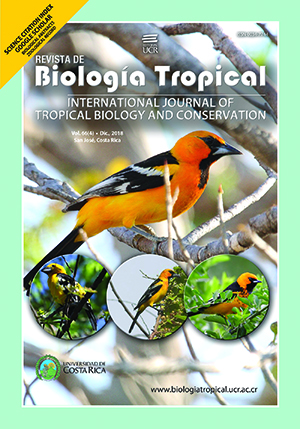Abstract
New antimalarial agents from plants are studied as alternatives in the treatment of malaria. The main antimalarials such as chloroquine have several mechanisms of action against parasites, one of which is the inhibition of polymerization of the heme group, a model that has allowed the design of new antimalarial candidates. In this sense the objective of this work was to evaluate extracts of genus Piper and Calophyllum plants on the inhibition capacity of β-hematin. Inhibitory concentrations of β-hematin are reported from 40 extracts of different polarity obtained from the species P. piedecuestanum, C. brasiliense, C. longinforium, and Calophyllum. sp. 19 extracts showed a greater potential to inhibit β-hematin with IC50 > 3 mg/ml. These activities mainly support future studies with the genus Calophyllum in the development and discovery of new antiplasmodial substances with known modes of action.
References
Asghari-Khiavi, M., Vongsvivut, J., Perepichk, I., Mechler, A., Wood, B. R., McNaughton, D., & Bohle, D. S. (2011). Interaction of quinoline antimalarial drugs with ferriprotoporphyrin IX, a solid state spectroscopy study. Journal of Inorganic Biochemistry, 105(12), 1662-1669.
Benevides, P. J., Sartorelli, P., & Kato, M. J. (1999). Phenylpropanoids and neolignans from Piper regnellii. Phytochemistry, 52(2), 339-343.
Chin, J. (2001). El control de las enfermedades transmisibles (17° Edición). Maryland, EUA: Organización Panamericana de la Salud.
Christopher, A., MacRaild, M., Pedersen, R., & Anders, R. (2012). Lipid interactions of the malaria antigen merozoite surface protein 2. Biochimica et Biophysica Acta, 1818, 2572-2578.
Egan, T. J., & Ncokazi, K. K. (2005). Quinoline antimalarials decrease the rate of β-hematin formation. Journal of Inorganic Biochemistry, 99(7), 1532-1539.
Egan, T. J. (2008). Recent advances in understanding the mechanism of hemozoin (malaria pigment) formation. Journal of Inorganic Biochemistry, 102(5-6), 1288-1299.
Fidock, D. A., Rosenthal, P. J., Croft, S. L., Brun, R., & Nwaka, S. (2004). Antimalarial drug discovery: efficacy models for compound screening. Nature Reviews Drug Discovery, 3(6), 509-520.
Fitch, C. D. (2004). Ferriprotoporphyrin IX, phospholipids, and the antimalarial actions of quinoline drugs. Life Sciences, 74(16), 1957-1972.
Gelb, M. H. (2007). Drug discovery for malaria: a very challenging and timely endeavor. Current Opinion in Chemical Biology, 11, 440-445.
Gupta, M. P., Arias, T. D., Correa, M., & Lamba, S. S. (1979). Ethnopharmacognositc observations on Panamanian medicinal plants. Part I. Quarterly Journal of Crude Drug Research, 17(3-4), 115-130.
Kumar, S., Guha, M., Choubey, V., Maity, P., & Bandyopadhyay, U. (2007). Antimalarial drugs inhibiting hemozoin (β-hematin) formation: A mechanistic update. Life Sciences, 80(9), 813-828.
Liu, X., Wang, Y., Liang, J., Wang, L., Qin, N., Zhao, Y., & Zhao, G. (2018). In-depth comparative analysis of malaria parasite genomes reveals protein-coding genes linked to human disease in Plasmodium falciparum genome. BMC Genomics, 19(1), 312.
Londoño, B., Carmona, J., & Blair, S. (2002). Comparación de los métodos Optimal y gota gruesa para el diagnóstico de malaria en una zona endémica sin epidemia. Biomédica, 22(4), 466-475.
MacRaild, C. A., Pedersen, M. Ø., Anders, R. F., & Norton, R. S. (2012). Lipid interactions of the malaria antigen merozoite surface protein 2. Biochimica et Biophysica Acta (BBA)-Biomembranes, 1818(11), 2572-2578.
Noldin, V. F., Isaias, D. B., & Filho, C. V. (2006). Calophyllum Genus: Chemical and pharmacological importance. Química Nova, 29(3), 549-554.
Olumese, P. (2005). Epidemiology and surveillance: changing the global picture of malaria-myth or reality? Acta Tropica, 95(3), 265-269.
Organización Mundial de la Salud (OMS). (2016). Estrategia Técnica Mundial contra la Malaria 2016-2030. Organización Mundial de la Salud. Ginevra, Suiza: Recuperado de http://www.who.int/malaria/publications/atoz/9789241564991/es/
Organización Mundial de la Salud (OMS). (2017). World malaria report 2017. Geneva, Suiza: World Health Organization Press. Retrieved from http://www.who.int/malaria/publications/world-malaria-report-2017/report/en/
Osorio, E. J., Arango, G., García, E., Muñoz, K., Ruiz, G., Gutiérrez, D., & Paco, M. A. (2005). Actividad Antiplasmódica In Vitro e Inhibición de la Formación de la β-Hematina de Plantas Colombianas de la Familia Annonaceae. Acta Farmacéutica Bonaerense, 24(4), 527-32.
Osorio, E., Arango, G., García, E., Muñoz, K., Ruiz, G., Gutiérrez, D., & Giménez, A. (2005). Actividad antiplasmódica in vitro e inhibición de la formación de la β-hematina de plantas colombianas de la familia Annonaceae. Acta Farmacéutica Bonaerense, 24(4), 527-532.
Osorio, E. J., Montoya, G., Muñoz, K., & Arango, G. (2006). Actividad antiplasmodial de alcaloides aporfínicos de Rollinia pittieri y Pseudomalmea boyacana (Annonaceae). Vitae, 13(1), 49-54.
Parapini, S., Basilico, N., Mondani, M., Olliaro, P., Taramelli, D., & Monti, D. (2004). Evidence that haem iron in the malaria parasite is not needed for the antimalarial effects of artemisinin. FEBS letters, 575(1-3), 91-94.
Parapini, S., Basilico, N., Pasini, E., Egan, T. J., Olliaro, P., Taramelli, D., & Monti, D. (2000). Standardization of the physicochemical parameters to assess in vitro the β-hematin inhibitory activity of antimalarial drugs. Experimental parasitology, 96(4), 249-256.
Prasad, A. K., Tyagi, O. D., Wengel, J., Boll, P. M., Olsen, C. E., Bisht, K. S., & Parmar, V. S. (1995). Neolignans and a lignan from Piper clarkii. Phytochemistry, 39(3), 655-658.
Robert, A., Dechy‐Cabaret, O., Cazelles, J., Benoit‐Vical, F., & Meunier, B. (2002). Recent advances in malaria chemotherapy. Journal of the Chinese Chemical Society, 49(3), 301-310.
Vargas, S., Ioset, K. N., Hay, A. E., Ioset, J. R., Wittlin, S., & Hostettmann, K. (2011). Screening medicinal plants for the detection of novel antimalarial products applying the inhibition of β-hematin formation. Journal of Pharmaceutical and Biomedical Analysis, 56(5), 880-886.
##plugins.facebook.comentarios##

This work is licensed under a Creative Commons Attribution 4.0 International License.
Copyright (c) 2018 Revista de Biología Tropical







